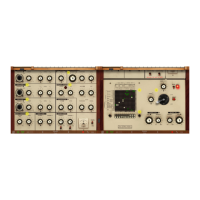Another difference between the Original Analogue DK and iVCS3 DK is the
“Legato behavior”. In the Original DK, the priority goes to the highest note,
this means that if you're holding down a note, the lowest notes can not be
played until you release the held note.
Now you can switch between the Original VCS3 legato and NEW (to improve
the playability of the keyboard on the ‘legato’) through the Settings.
! Locking the DK Keyboard (in the DK Keyboard) means that every note
is sustained. So when you play a note it will hold the last pressed key even
when you lift your finger from the keyboard. When the Keyboard is locked,
Snapshots will save/restore touched keys, see Settings for more
explanations.
Sequencer
Also note that the DK Keyboard puts a 1V for octave output, so you need to
trim this voltage using the Input Level Channel 1 or 2 to 0.32v if you want 12
notes within an octave. If input level knobs are at other settings you will get +-
tones per keyboard octave, this is good for using other scales like quarter
tone, 19 or 21 notes/octave.
Sequencer is fully programmable, you can impose direction, steps number,
tempo and random direction from the Sequencer Manager, while Groove
Values sets information for every step.
We have two independent groove values, one for the DK and another for the
Joystick. Every groove takes two values for every step: Key and Dynamics.
An auxiliary groove with one parameter is for Channel 1 Panning and is
expressed as an absolute and will overwrite (when enabled) Ch1 PAN (Ext.)
in the Main Panel. Joystick and Panning Grooves can be disabled. In order to
record values in the Groove, you will need to Tap DK or STICK buttons and
Keyboard AKS information will be shown. With KS you can program Keys and
Dynamics. Dynamics are controlled by playing keys along the key’s vertical: 0
V in the middle part of the key height, pianissimo at the top and fortissimo at
the bottom (see Dynamic Range for more details). DK Groove values are
strictly correlated to DK values.
When you enable ‘Record’ in KS (Sequencer), every note will skip to next
Sequencer groove step, allowing consecutive notes and dynamic
programming. And for Random and Fifth, Third, etc tone buttons: the Random
will play a random note every time you push it. It works for the current groove
step or also when recording a sequence (‘Record’ enabled). The other
buttons will transpose the sequence! by the amount it says and they can be
combined (you can touch several at time for doing more intervals). These

